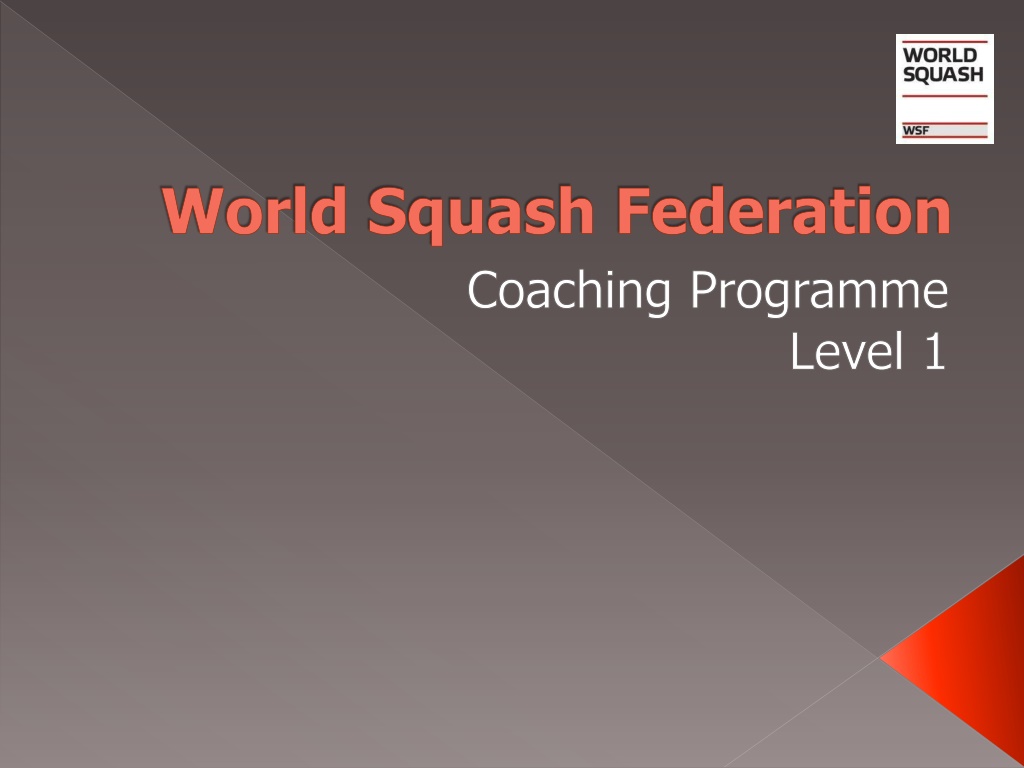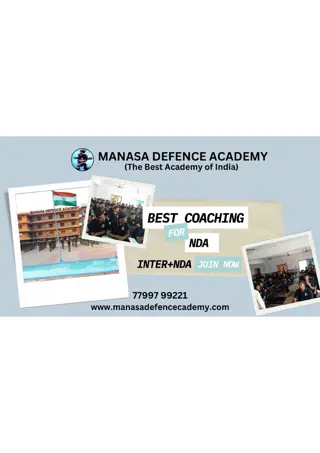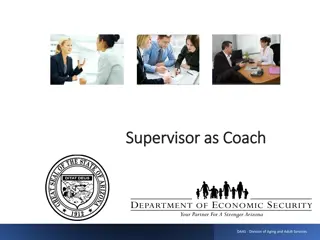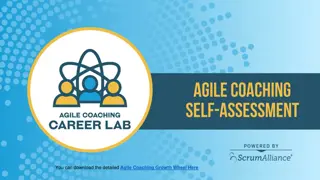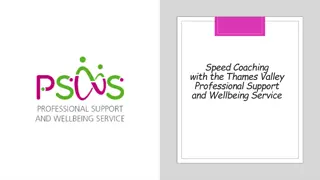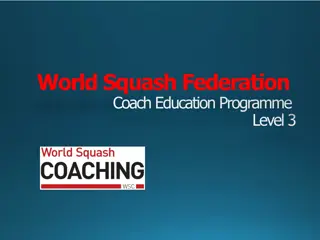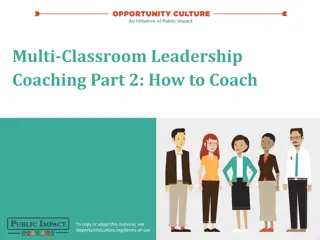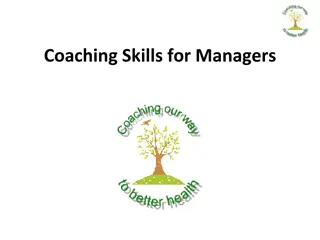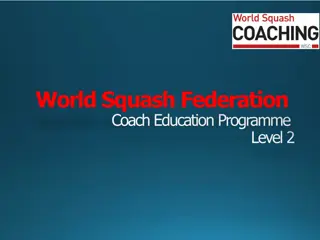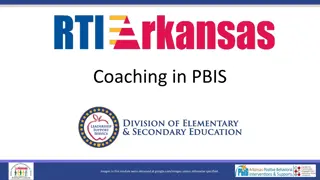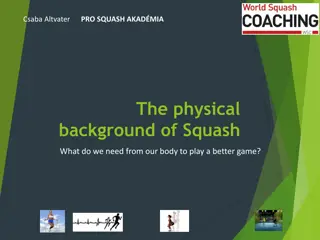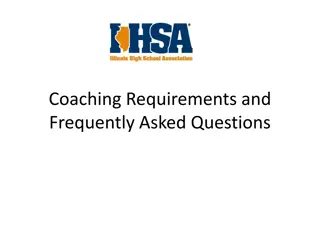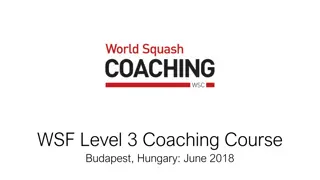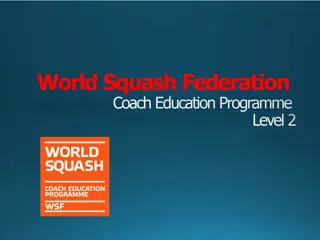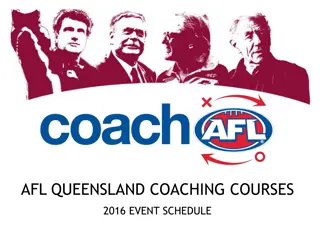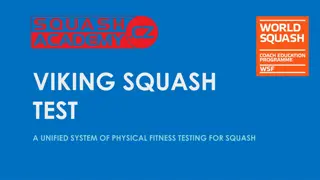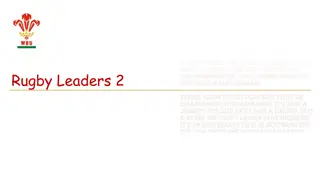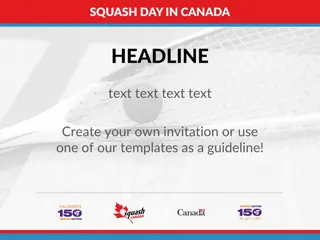Understanding the World Squash Federation Coaching Programme Level 1
The World Squash Federation Coaching Programme Level 1 focuses on improving coaching quality in squash globally. It emphasizes the importance of HOW to coach, incorporating a philosophy of Perception Decision Action (PDA) Process and Long-Term Player Development (LTPD). The programme equips candidates with essential tools to effectively coach early learner players and emphasizes continuous improvement and evolution in coaching practices.
Download Presentation

Please find below an Image/Link to download the presentation.
The content on the website is provided AS IS for your information and personal use only. It may not be sold, licensed, or shared on other websites without obtaining consent from the author. Download presentation by click this link. If you encounter any issues during the download, it is possible that the publisher has removed the file from their server.
E N D
Presentation Transcript
World Squash Federation Coaching Programme Level 1
Why a WSF Coaching Programme? A WSF initiative to improve the quality of coaching Squash across the World It provides quality assurance and control of safe and World best practice It provides the opportunity to work together and share information Collective Knowledge & Collective Experience Clear emphasis on HOW to Coach
Philosophy How Squash is judged Open skill = Perception Decision Action (PDA) Process LTPD Biological windows Neurological pathways Based on Knowledge of how squash is played Skill of Delivery of passing information Lesson Planning = Process & use of TOOLS of HOW to coach
Contd The BIG mistake is to just look at the what when it is the HOW that moves theory into practice It is a PROCESS!! Order Thoughts be Explicit To know and not to do is to NOT KNOW! If you have 15 years experience Please use it Do NOT repeat 1 years experience 15 times! Evolution not Revolution!
WSF Level 1 Certificate will enable candidates to: Understand the role of a Coach to effect positive development of early learner players Understand the process of coaching Tools Effectively demonstrate and use the coaching tools skilfully Plan and incrementally deliver a series of lessons to early learner squash players
Competency 1 Knowledge and Understanding At the end of this module coaches will be able to: Relate to other coaches and tutors on the course Self -reflect as a coach Understand the role of a WSF Level 1 coach within the WSF coaching Programme Understand the coaching process of Learning to Play - Simple Rallies PDA cycle for squash Understand the purpose of Generic Skills Understand the purpose of Long Term Player Development Understand the use of Coaching Tools PDA cycle for coaching Simple Rallies in squash Describe the use of Tools and how they are used to effect positive change for early learner players 1. 2. 3. 4. 5. 6. 7. 8.
Competency 2 Skill of Delivery By the end of this module, coaches will be able to demonstrate that they can: Understand HOW to relate to early learner squash players Understand different learning styles of players and the need for different coaching styles Understand the key principles of Introduction and Demonstration Demonstrate and introduce the key principles of WWWH to the grip Warm Ups Demonstrate and introduce the key principle of WWWH to service, drives, boasts, drops and volleys into simple rallies progressively Understand and demonstrate the patterns of movement within simple Open Skill rallies in squash Safety on Court Demonstrations Observe, diagnose faults and provide feedback to progress performance of simple rallies PRACTICAL USE OF THE TOOLS
Competency 3 Lesson Planning to Effect Positive Change Learning outcomes: by the end of this module, coaches will be able to demonstrate that they can: Understand and describe the differences between coaching an individual and groups Plan and deliver a progressive series of individual lessons to develop simple rallies; observing, diagnosing areas for improvement and providing feedback to improve positive change Plan and deliver a progressive series of group lessons of modified fun games and simple rally situations; observing, diagnosing areas for improvement and providing feedback to improve positive change
Assessment Criteria 1.2 The assessment takes three parts: Brief Written Lesson Plan on a given topic to deliver in real time between 20 & 30 minutes Skill of Delivery of the safe practical delivery of individual and / or group lesson A Question and Answer session with the tutor / assessor based on the course syllabus
Coaches need to Know & Do 2.3 Tutor highlights the difference between tutoring and coaching: Tutoring is where the tutor guides the course candidates in detail through a process that examines the theory and practice of what and how squash is learnt and played Coaching is where the coach nurtures the player using his knowledge and understanding of how squash is played in open rallies and his skill of enabling players to be able to practically play a series of simple rallies the player does not necessarily need all the theory but to practically perform the skills
Role of a Coach 3.2 Sally Sunflower Does a sunflower grow itself or does the gardener grow it? If you want an oak tree would you plant a sunflower seed? How quickly can a sunflower grow to maturity? Coaches are like gardeners in that we assist / provide the environment in which the player will grow into what is in the genes Squash is an open skill best learned in the sub- conscious
How Squash is Measured 4.1 Squash is best learned in Perception Decision Action 4.1.3 Spiders web 4.1.6
LTPD Learning to Play Simple Rallies - WSF Level 1 syllabus Learning to Train Skill / Accuracy WSF Level 2 syllabus Training to Compete Tactics / Apply Pressure WSF Level 3 syllabus Training to Win Sum of all the above
Key Factor 1 The 10 Year Rule 10k to 15k hours to reach elite levels This equates to more than 3 hours daily for 10 years Sorry But there is NO world champion pill!
Key Factor 2 FUNdamentals All sports are built on the practical application of Generic Movement Skills ABCS Agility Balance Coordination Speed/Strength/Stamina
Key Factor 3 Specialisation Early specialisation Gymnastics Figure skating usually closed skill sports Later specialisation Squash Tennis Football Basketball usually open skill sports
Key Factor 4 Development Age Everyone passes through the same phases of development from birth to adolescence, although NOT at the same rate The timing and rate of development varies Which is the difference between chronological age and development age Two children may be the same age but at a different development age. The two could be up to 5 years difference
Key Factor 5 Trainability Trainability is the developing bodies responsiveness to training at different stages of growth and maturation Certain windows of training opportunity appear at different stages of development During the early stages of adolescence (Growth spurt usually around 12years) girls can start training for strength / speed / stamina (Boys around 14years)
Key Factor 6 Physical/Mental/ Cognitive/Emotional Development Coaches need to be sensitive as players grow through adolescence The risk of Burnout is high during this period from lack of confidence/Emotional Stress/Anxiety Veteran juniors
Key Factor 7 Periodisation Periodisation is a logical, science based programme of training for competition / Preparation / Physical training / Recovery Which require modification at each phase of growth / maturation / trainability
Key Factor 8 Calendar Planning During the adolescent phase competition should be viewed as an essential learning environment (NOT JUST WINNING!) in balance with the windows of opportunity for physical and emotional development
Key Factor 9 Integration / Balance Squash (Physical development) should be regarded as integral to overall wellbeing and be in synch with other lifestyle issues such as education / social development etc
Key Factor 10 Continuous Improvement LTPD is based on the scientific study of training linked to what good coaches have being doing for many years There is no such thing as intellect without first instinct Coaches need to constantly respond to new knowledge and levels of understanding
Windows of Training Opportunity Stamina During growth spurt moving into aerobic power as the growth spurt slows down Strength Girls immediately after growth spurt and during the onset of menarche. Boys only have 1 window starting 1 year after growth spurt Speed girls between 6-8 years & 11-13 years. Boys 7-9 years & 13-16 years / 1stphase on agility and quickness 2ndphase anaerobic alactic energy system
Windows Contd Skill (Rally building Fundamental movement) Girls 8-11 years Boys 9-12 years Suppleness Girls 8-11 years Boys 6-10 years With special attention during the growth spurt Psychology Squash is a mental, physical challenge whilst maintaining high levels of concentration Mental toughness both in competition & training is essential to success in squash and can enhance everyday life
The Tools What-Why-When-How Ordering thoughts: A way of thinking! Four questions and three words: What-Why-When-How (PDA) 7.1 What does the player want to be able to do? Why it is important to do it? When would it be appropriate to do it? How it could be achieved?
Grip 8.1 WHAT - Controls the angle, direction and speed of the racket head The angle and direction of the racket head controls the trajectory speed accuracy of the ball All the time By gripping the racket handle with the forefinger and thumb in a V shape on the handle, the three remaining fingers loosely coming around the handle so that the handle is cupped gently in the fingers WHY - WHEN - HOW -
George 8.3 WHAT - The natural height and distance in relation to the body for the racket hand on impact with the ball Helps coordination of the body movement to the moving ball WHY - WHEN - HOW - All the time out of choice To establish George for course candidates is to hold the racket in the non-playing hand using the grip as listed above Using the BH side gently bounce the ball to maximum head height Have the candidates establish how high in relation to the body is the point of contact Change to the FH side and repeat the task N.B. Ensure that the point of contact stays at the same height which will then establish the natural distance of point of contact in relation to the body - Links to the Radar
Radar 8.4 WHAT - Tracks the position of the ball in relation to body WHY - Helps coordination of the body movement to the moving ball WHEN - All the time HOW Point to the ball with the free hand
Relaxed Rhythm 8.6 What Tool that encourages the early learner to relax both grip and their whole body To release the body of excessive tension Why When Either moving into position or striking the ball How Make it a focus of attention and experience the difference
Action to Result 8.8 What Links the racket action to where the ball travels Why Allows the player to determine where ball travels with accuracy When All the time How - By changing the action the ball goes to a different target
The Clock 8.10 What Diagnostic tool to identify what are likely causes of skill based problems It is a systematic and accurate way to find underlying issues All the time Why When How - Under the headings of Perception @ 12 o clock Decision @ 4pm Action @ 8pm. Starting @ 12 look to see if the player is reading the opponents actions and the ball / @ 4pm onwards look to see if they are choosing a good striking position / and 8pm onwards looking to see if the player is developing a good striking action
0 to 100 8.12 What A measure of a player s level of competency judged NOT BY STYLE but by a level of accuracy of what the player makes the ball do! Sets a level of success and work level for optimal learning Why When All the time How - Observation of the success level in a routine/drill success rate of 9 or 10 out of 10 successes then the drill is too easy less than 4 out of 10 is too difficult range of 5 to 8 out of 10 is good
When Problems- Do Less 8.14 What The tool to measure the degree of difficulty for the player Allows the player to learn in the subconscious Why When All the time How - Taking information away from the player focus attention on only one of the TOOLS STOP speaking and let them try
Spiders Web 8.16 What Allows players to learn Simple Rallies at their own rate progressively Tool that shows the process of progressive skill building from Closed skills to Open All the time Why When How - PDA - Be Explicit not implicit on the 3 areas of focus
Show & Test 8.17 What Tool that shows the differences in racket actions that makes the ball go to different targets Enables the player to recognise the signals of where the opponent is going to strike the ball Focus on opponent just before they strike the ball PDA Highlight the process of PDA i.e. The focus of the different racket actions required to make the ball travel to different targets (Perception) To recognise when is good opportunity (Decision) and finally to execute (Action) Why When How -
Competency 2 By the end of this module, coaches will be able to demonstrate that they can: Understand HOW to relate to early learner squash players Understand different learning styles of players and the need for different coaching styles Understand the key principles of Introduction and Demonstration Demonstrate and introduce the key principles of WWWH to the grip Warm Ups Demonstrate and introduce the key principle of WWWH to service, drives, boasts, drops and volleys into simple rallies progressively Understand and demonstrate the patterns of movement within simple Open Skill rallies in squash Safety on Court Demonstrations Observe, diagnose faults and provide feedback to progress performance of simple rallies PRACTICAL USE OF THE TOOLS 1. 2. 3. 4. 5. 6. 7. 8. 9. 10.
Demonstration Principals 3.0 SHOW - with a partner helper in a rally situation briefly show the skill being demonstrated to create a visual image briefly explain the key issues around PDA whilst highlighting the key issues, progressively drawing the groups attention verbally at the same time organise the group to practice the skill of performing a good demonstration TELL - SHOW AGAIN- TRY -
Demonstration Warm Up 5.0 What Warm up is the process by which we prepare the Body and Mind to practice and or play squash Why Prevents injuries allows everything to work at full speed Before training practice competition When How - Jogging / Stretching / Shadow play / Striking
Demonstration Lifting Drive Length 6.9 What Strike the ball to first hit the front wall mid way above the service line and the out line to then travel as close to the side wall as possible bounce on the floor just behind the service box Why To try to force your opponent into a back corner away from the T- zone When When Your opponent is on the T-zone or in front of you How - P - Focus on your partners actions when your partner is striking the ball D - Decide where you want to time the ball (i.e. make contact with the ball) and the target to length A - Moving from the T-Zone into a position facing the side wall with the racket up. The racket begins to move down and forward to a point of contact at George with a loose Grip following through on the recovery back to the T-zone
Demonstration Drop 9.1 What You want the ball to do strike the ball to hit low on the front wall, to then bounce on the floor close to the wall To push partner to the front corner of the court Why When Your partner is behind How - P - Focus on your partners actions when your partner is striking the ball D - Decide where you want to time the ball (i.e. make contact with the ball preferably early on the volley) and the target short to strike the front wall half way between the Tin and the service line A - Moving from the T-Zone into a position facing the side wall with the racket up. The racket begins to move down and forward to a point of contact with a loose Grip following through, recovering back to the T-zone
Demonstration 3 Wall Boast 9.8 What Strike the ball to hit the side-wall front wall near the service-line the opposite side-wall to then bounce on the floor having lost pace at the front part of the court To force partner to move away from the T-zone Why When Ball has gone past players body OR is not looking How P - Focus on your partners body actions and their racket actions when they are striking the ball D - Decide where you want to time the ball (i.e. make contact with the ball) and the target diagonally at the front of the court A - Moving from the T-Zone into a position facing the nearest back corner. The racket moves forward and with a lifting movement to a point of contact at George with a loose Grip following through on the recovery back to the T-zone
Demonstration Cross-Court Drive / Length 9.9 What Aim to hit the front wall just off-centre side wall at the back of the service box To move your partner away from the T-Zone Why When Your partner is at the front or the other side of the court How P - Focus on your partners body actions and their racket actions when they are striking the ball to try and predict where the ball will travel D - Decide where you want to time the ball during its flight and the target on the side wall A - Moving from the T-Zone into a position facing the nearest front corner. The racket moves forward and with a lifting movement to a point of contact at George with a loose Grip following through on the recovery back to the T-zone
Demonstration Service 9.18 What The ball must strike the front wall between the service and out lines to bounce in the opposite back court behind the short line this can be the same as a lob or drive to length To put the ball in play and put the opponent under pressure The start of every rally Why When How With a foot in a service box with your free hand throw the ball to a position that is favourable to you and strike
Straight Volley Return of Service What To strike the ball at a high point before it bounces to first hit the front wall mid way above the service line and the out line to then travel as close to the side wall as possible and to bounce on the floor behind the service box Why To try to force the opponent into a back corner away from the T-zone When Your opponent is on the T-zone or in front of you How P - Focus on your partners service action when they strike the ball D Making your decision to strike the ball on the volley before it drops to the ground A Moving from the T-zone into a position facing the side wall with the racket high, moving forward to strike the ball at the highest level possible with a loose grip, short action and recovering back to the T- zone
Diagnostic Clock 10.2 What The PDA when used as a clock is a diagnostic tool to highlight areas of development for early learner players Why It provides the coach with a process / procedure in context and chronological sequence of the elements of open rallies in squash The early learner player has difficulty in progressing a skill Search starting at 12 to 1,2,3,4 etc through to 12 Work on the small numbers first through to 12. Using the Tools as areas of focus to assist progression and development When How
Competency 3 1. Understand and describe the differences between coaching an individual and groups 2. Plan and deliver a series of individual lessons to develop simple rallies for squash, observing, diagnosing areas for improvement and providing feedback to improve positive change 3. Plan and deliver a series of group lessons of modified fun games and a simple rally situation for squash, observing, diagnosing areas for improvement and providing feedback to improve positive change
Lesson Planning 2.1 & 2.2 All lessons will include: Warm up Process of Assessment of the Players The Clock PDA Find problem areas Diagnosis Prioritise what is causing the problem - Likely issues Demonstration of Skill being introduced Show / Tell / Try IDEAS Introduction/Demonstration/Explanation/Action/Summary Highlight a single area for the player to focus attention on to improve Let them try Closed skill progressing to Open Skill Up or down 0-100 When Problems do less! Skills practice Games - Modified / Conditioned / Fun Competition practice if appropriate Cool down Summing up lesson / Closure
